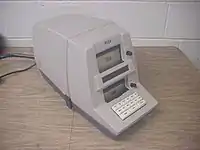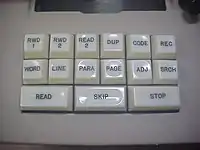CPT Corporation
CPT Corporation was founded in 1971 by Dean Scheff in Minneapolis, Minnesota, with co-founders James Wienhold and Richard Eichhorn.[1] CPT first designed, manufactured, and marketed the CPT 4200, a dual-cassette-tape machine that controlled a modified IBM Selectric typewriter to support text editing and word processing.
| CPTC, National Over the Counter | |
| Industry | Word Processing |
| Fate | Discontinued operations in the mid 1990s |
| Founded | 1971 |
| Founder | Dean Scheff |
| Headquarters | Factories in USA and Ireland, Eden Prairie, Minnesota , United States |
Area served | World wide |
| Products | Stand-alone word processing machines |
| Revenue | $200,000,000 annually max |
Number of employees | 2000 |
The CPT 4200 was followed in 1976 by the CPT VM (Visual Memory), a partial-page display-screen dual-cassette-tape unit, and shortly thereafter by the CPT 8000, a full-page display dual-diskette desktop microcomputer that drove stand-alone daisy wheel printers.
Subsequent products included (1) variants on the 8000 series; (2) the CPT 6000 series, which had a lower capacity, smaller screen, and was less expensive; (3) the CPT 9000 series, which had a larger capacity and could run IBM personal computer software; (4) the CPT Phoenix series, which had a graphical capabilities; (5) CPT PT, a software-only reduced version that ran on IBM personal computers and clones; and (6) other related products.[2]
The CPT logo—originally three letters chosen to sound well together—began to be taken as an acronym for "cassette powered typewriting," and subsequently for "computer processed text," and numerous other variants. Major competition was IBM, Wang, Lanier, Xerox, and other word processing vendors.[3]
CPT Corporation was fifth in size among Minnesota-based top high-tech companies, after 3M, Honeywell, Control Data, and Medtronic.[4] Corporate revenues grew to approximately a quarter-billion dollars per year in the mid-1980s, then declined with the proliferation of personal computers. CPT ultimately ceased major manufacturing late in the 20th century.
Selected products
Cassette based



The CPT 4200 was a dual-cassette-tape unit with a small built-in keyboard that controlled a modified IBM Selectric typewriter. Keystrokes entered on the typewriter appeared on the paper as they were recorded on the output cassette, which formed a magnetic replica of the characters printed on the page. That output cassette could later be used as an input cassette, where it would be played back to the typewriter along with new keystrokes to accomplish text editing.
The keyboard of the CPT 4200 had action keys for "skip", "read" and "stop", mode keys for "word", "line", "paragraph," and "page." Pressing "read" transferred a word, line, paragraph, or page (depending on which mode key had been selected) from the input tape to both the typewriter and the output tape. Line boundaries (aka printer margins) recorded on the input tape were ignored or retained depending on whether or not the "adjust" key had been selected. Alternatively, pressing "skip" moved past the corresponding amount of text on the input tape without sending it to the typewriter or to the output tape.
The Selectric's keyboard was active for any new typing, which would appear on the paper and transferred to the output tape. Thus a document was edited by reading back those parts of the text to be retained and skipping those parts to be discarded, with new typing added from the Selectric's keyboard. Price: approx. $5000, 1980-era values.
The CPT Communicator was an add-on to the CPT 4200 that allowed data to be transferred from one text-editing machine to another, or between a text-editing machine and a remote computer, via phone lines. Price: not available.
CPT 8000 series


The CPT 8000 was the company's first microcomputer product, exhibited in spring of 1976. It was a self-contained desktop machine with two 8 inch floppy diskette drives, a movable keyboard, and a full-page vertically oriented CRT display with black characters on a white background, for a wysiwyg view of text on paper. It was promoted as familiar and easy to use for those experienced with typewriters.
The CPT 8000 had dual-window editing, where text was assembled in an upper window from text entered at the keyboard or from one or more files brought successively into the lower window. Words, lines, paragraphs, and pages could be slid from the lower window to the upper, as in the cassette tapes of the CPT 4200, or they could be deleted from the lower window. In addition the two screens could lock and scroll up or down together.
The machine used two processors, an 8080 microprocessor and a custom display processor. 65,536 bytes of main memory were standard and were used jointly by both processors for executable code, program data, and video memory. Price: approx. $15,000, 1980-era values.
An RS-232 serial communication option was available for the 8000 series that allowed the electronic transfer of documents.
CPT Phoenix series

The CPT Phoenix had a separate adjustable display, a separate curved keyboard promoted as ergonomically comfortable, and circuitry in a separate box. It included a custom bit-block-transfer (BitBlt) graphics processing unit (GPU) together with a dual-CPU multiprocessor. Eight of the keys on the keyboard were "soft keys" whose meaning changed with the operation being performed and whose current definitions were maintained at the bottom of the display screen. Price: approx. same as CPT 8000.
CPT WordPak
The CPT WordPak series was CPT's first external document storage system that enabled multiple 8000 series workstations to store documents in an electronic filing cabinet.
Prior to WordPak, all documents were stored on removable 8 inch floppy diskettes. Sharing documents involved handing off the original disk, or copying the document to a second disk and 'sneaker-net-ing' (walking it over) to the second 8000. But this resulted in two copies of the document, one at each workstation.
A circuit card with the proprietary cable connector was installed in the 8000 series workstations and connected to the WordPak by a multi-conductor cable. (This was before the Ethernet standard was developed.)
WordPak 1 consisted of a single Shugart Associates 14" diameter hard disk drive with a capacity of 5 megabytes.
WordPak 2 added a 2nd drive for a total of 10 megabytes.
WordPak was designed to support the 8000 series 'fixed font pitch' documents, which did not support imbedded graphics. It was the forerunner of the SRS product.
CPT SRS
The CPT SRS was a "shared resource system" consisting of a 35-million-byte hard disk drive that would be shared simultaneously by up to eight CPT word processing machines. At that time photographs and videos were not commonly stored digitally and a disk drive of that size could hold a shared document of up to 10,000 pages or more.
CPT PT software

CPT PT was a reduced a version of the software that ran under MS-DOS as an application on IBM PC compatible computers.[7] The corporation intended it as a bridge to allow data to flow in and out of personal computer packages, as well as providing a personal-computer word processing application for those familiar with standalone CPT equipment or who preferred the CPT style of dual-window text editing. Price: approx. $200, 1980-era values.
CPT Genius Display
The Genius display was a stand-alone vertically oriented (portrait) configuration monochrome grey-scale CRT monitor unit and an IBM PC form factor display card to allow high resolution full page text & graphics on IBM PC compatible computers. A special MS-DOS driver was required, but allowed a text screen to be 80 characters wide and 66 lines tall (a normal printed page parameters). The display unit looked similar to that of the Phoenix monitor (minus the keyboard) shown in Figure 6 above.
Text editors such as Quicksoft's PC-Write, WordPerfect, WordStar, VolksWriter (and more) supported the full page mode. Lotus Symphony and 1-2-3 would support full page as well as dual screen mode (2 'regular' landscape screens, one in the top half of the screen with the other below.
Windows 3.0 drivers were also developed for this product that allowed for full page screen presentations, just like their dedicated word processors, but with the addition of monochrome graphics.
Some specifications:
9x15 pixel character cell
8x12 pixel character matrix, includes 3 scan line for descenders (i.e. letters g,j,p...)
13th scan line for underscore
progressive scan, 60 Hz vertical refresh rate
64 kHz horizontal scan rate
100 MHz video bandwidth
15" diagonal, 110 degree deflection, paper white, long persistence phosphor
(from at-the-time marketing literature)
The product was originally developed by Micro Display Systems of Hastings Minnesota as the VHR-400. Price: unknown
Daisy Wheel Printers
Daisy wheel printers from Qume Corporation and Diablo Systems could be connected to the 8000 and 8500 series word processors. These printers could support both fixed pitch and proportional fonts, but could not print graphics/pictures. Price: unknown
Laser Printers
Laser printers were required for printing the documents produced by the Phoenix series word processors as the documents produced could contain embedded graphics. Price: unknown
Nameplates of selected products
.jpg.webp)
References
- Blogett, Bonnie (1981). "The Keyboard Wizardry of Dean Scheff: For Love and Money, CPT at 10". Corporate Report Minnesota. Dorn Communications, Inc. 12 (5): 65–70ff.
- Rollag Wangstad, Kristi, ed. (1983). "The CPT Product Line Then and Now". Bits and Bytes. CPT Corporation. 10 (11): 10–11.
- Erickson, Donna (1983). Rollag Wangstad, Kristi (ed.). "Hannover Fair 83: An overview of product highlights". CPT Times. CPT Corporation. 10 (5): 14–22.
- Novak, Jay, ed. (1983). "Minnesota's high-tech hierarchy". Corporate Report Minnesota. Dorn Communications, Inc. 14 (10): 63–69.
- Lehman, Fred (1990). "CRT Monitors for the 1990s". Information Display. 6 (4): 6–8.
- Krupinski, Elizabeth A.; Kallergi, Maria (2007). "Choosing a radiology workstation: Technical and clinical considerations". Radiology. 242 (3): 671–682. doi:10.1148/radiol.2423051403. PMID 17229874.
- Joyer, Nancy (1985). Rollag Wangstad, Kristi (ed.). "What can a CPT word processing package for IBM PCs do for you?". CPT Times. CPT Corporation. 12 (2): 12.